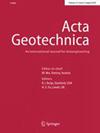A new root–soil interface contact model to simulate the overturning behaviour of root system architectures
Abstract
Correctly assessing overturning resistance of tree root systems is vital to designing sustainable and resilient urban forestry. In previous numerical modelling to investigate root anchorage behaviour, none of the root–soil contact models employed was able to capture slipping at the root–soil interface of complex root system architectures efficiently. This study proposed, derived and implemented a novel, computationally efficient, three-dimensional root–soil contact model that can capture interfacial strain-softening shearing behaviour for an arbitrary root system architecture independent from the spatial discretisation of the surrounding soil within a 3D finite-element model. Validation against existing pull-out test and centrifuge data revealed that the model well captured root pull-out and tree overturning behaviours. The validated model was subsequently used to investigate the transfer mechanisms of artificially generated root system architectures when growing with and without the presence of underground walls. Windward root segments that were more closely aligned with the lateral push provided the most contribution to resisting overturning. The presence of underground walls made the root system architecture highly asymmetric, forming a taproot complex that ‘interlocked’ the surrounding soil to provide overturning resistance. The walls also restricted the relative root–soil displacement, reducing the variability in the overturning moment.

 求助内容:
求助内容: 应助结果提醒方式:
应助结果提醒方式:


